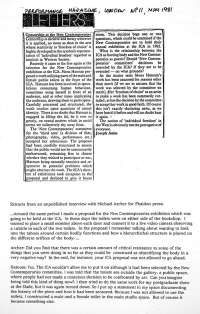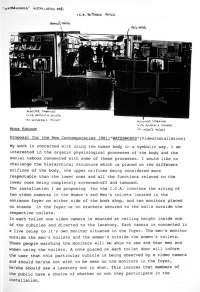Extracts from an unpublished interview with Michael Archer for Phaidon press:
...Around the same period I made a proposal for the New Contemporaries exhibition which was going to be held at the ICA. In those days the toilets were on either side of the bookshop. I wanted to place a small monitor above each door and connect it to a live video camera observing a cubicle in each of the two toilets. In the proposal I remember talking about wanting to look into the taboos around certain bodily functions and how a hierarchical structure is placed on the different orifices of the body. ...
Archer: Did you find that there was a certain amount of critical resistance to some of the things that you were doing in so far as they could be construed as objectifying the body in a very negative way? In the end, for instance, your ICA proposal was not allowed to go ahead.
Hatoum: Yes. The ICA wouldn't allow me to put it on although it had been selected by the New Contemporaries committee. I was told that the toilets are outside the gallery, a public space, where people had not made a conscious decision to be confronted by art. Can you imagine being told this kind of thing now?. I then tried to do the same work for my postgraduate show at the Slade, but it was again turned down. So l put up a statement in my space documenting the history of the piece and how it had been sensored. Because I was not allowed to use the toilets, l constructed a male and a female toilet in the main studio space. But of course it became something else.
(diagram)
Proposal for the New Contemporaries 198l: "WATERWORKS" (VideoInstallation)
My work is concerned with using the human body in a symbolic way. I am interested in the organic physiological processes of the body and the social taboos connected with some of these processes. I would like to challenge the hierarchical structure which is placed on the different orifices of the body, the upper orifices being considered more respectable than the lower ones and all the functions related to the lower ones being completely screened-off and tabooed.
The installation I am proposing for the I.C.A. involves the siting of two video cameras in the Women's and Men's toilets located in the entrance foyer on either side of the book shop, and two monitors placed on stands in the foyer or on brackets secured to the walls outside the respective toilets.
In each toilet one video camera is mounted at ceiling height inside one of the cubicles and directed to the lavatory. Each camera is connected in a live relay to it's own monitor situated in the foyer. The men's monitor outside the men's toilets and the women's outside the women's toilets. Those people watching the monitors will be able to see and hear men and women using the toilets. A note placed on each toilet door will inform the user that this particular cubicle is being observed by a video camera and should he/she not wish to be seen on the monitors in the foyer, he/she should use a lavatory not in shot. This insures that members of the public have a choice of whether or not they participate in the installation.
Extracts from an unpublished interview with Michael Archer for Phaidon press:
...Around the same period I made a proposal for the New Contemporaries exhibition which was going to be held at the ICA. In those days the toilets were on either side of the bookshop. I wanted to place a small monitor above each door and connect it to a live video camera observing a cubicle in each of the two toilets. In the proposal I remember talking about wanting to look into the taboos around certain bodily functions and how a hierarchical structure is placed on the different orifices of the body. ...
Archer: Did you find that there was a certain amount of critical resistance to some of the things that you were doing in so far as they could be construed as objectifying the body in a very negative way? In the end, for instance, your ICA proposal was not allowed to go ahead.
Hatoum: Yes. The ICA wouldn't allow me to put it on although it had been selected by the New Contemporaries committee. I was told that the toilets are outside the gallery, a public space, where people had not made a conscious decision to be confronted by art. Can you imagine being told this kind of thing now?. I then tried to do the same work for my postgraduate show at the Slade, but it was again turned down. So l put up a statement in my space documenting the history of the piece and how it had been sensored. Because I was not allowed to use the toilets, l constructed a male and a female toilet in the main studio space. But of course it became something else.
(diagram)
Proposal for the New Contemporaries 198l: "WATERWORKS" (VideoInstallation)
My work is concerned with using the human body in a symbolic way. I am interested in the organic physiological processes of the body and the social taboos connected with some of these processes. I would like to challenge the hierarchical structure which is placed on the different orifices of the body, the upper orifices being considered more respectable than the lower ones and all the functions related to the lower ones being completely screened-off and tabooed.
The installation I am proposing for the I.C.A. involves the siting of two video cameras in the Women's and Men's toilets located in the entrance foyer on either side of the book shop, and two monitors placed on stands in the foyer or on brackets secured to the walls outside the respective toilets.
In each toilet one video camera is mounted at ceiling height inside one of the cubicles and directed to the lavatory. Each camera is connected in a live relay to it's own monitor situated in the foyer. The men's monitor outside the men's toilets and the women's outside the women's toilets. Those people watching the monitors will be able to see and hear men and women using the toilets. A note placed on each toilet door will inform the user that this particular cubicle is being observed by a video camera and should he/she not wish to be seen on the monitors in the foyer, he/she should use a lavatory not in shot. This insures that members of the public have a choice of whether or not they participate in the installation.

